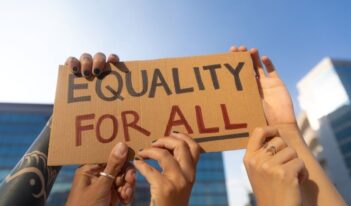
The Supreme Court again decries one form of discrimination while upholding another.
On the second-to-last day of the term, the U.S. Supreme Court issued its decision in Trump v. Hawaii, reversing the courts of appeals’ decisions that upheld preliminary injunctions against the President’s infamous entry ban. Trump addressed the third iteration of the President’s entry ban—the more permanent version that emerged from two interim bans, one of which contained an explicit religious preference, and the other warning of “so-called ‘honor killings.’” The decision quickly drew harsh commentary, which included scholars and political figures such as U.S. Representative John Lewis (D-Ga.) likening the decision to some of the Court’s worst mistakes of the past, including Dred Scott v. Sandford, Plessy v. Ferguson, and Korematsu v. United States.
Korematsu and the entry ban cases have drawn many comparisons, ever since the President first announced his plan for a total and complete shutdown of Muslims entering the United States and justified the proposal by invoking Korematsu. The Court in Korematsu upheld an order forcing Americans of Japanese descent into internment camps; President Donald Trump’s entry ban prohibits foreign nationals of several countries, most of which are majority Muslim, from entering the United States, even as refugees. Despite comparisons between the two policies, the Chief Justice’s 5-4 majority opinion in Trump decided to use the case as an opportunity to denounce Korematsu as wrongly decided.
The moment the Court denounced Korematsu was a bittersweet one, at best. People have waited over 70 years for the Court to officially renounce the case, and it was a mere seven years ago that the Solicitor General’s office admitted error in Korematsu and acknowledged that the federal government had not been forthcoming with evidence that the internment order rested less on national security and more on naked racism (there was already plenty of evidence on that point in the public record).
Part of what made the Court’s denunciation of Korematsu so bittersweet is that the majority appeared only to deign to denounce the decision in response to the powerful dissent by Justice Sonia Sotomayor that invoked the many parallels between the entry ban and the internment order in Korematsu.
As Justice Sotomayor pointed out, in both cases “the Government invoked an ill-defined national security threat to justify an exclusionary policy,” “the exclusion order was rooted in dangerous stereotypes,” and “the Government was unwilling to reveal its own intelligence agencies’ views of the alleged security concerns to the very citizens it purported to protect.”
In response, Chief Justice John Roberts wrote that “the dissent’s reference to Korematsu…affords this Court the opportunity to make express what is already obvious: Korematsu was gravely wrong the day it was decided.”
But the Court’s “overruling” of Korematsu—if you can even call it that—was even worse than that dismissive opprobrium. It was also a telling example of how the Court regularly reinforces discrimination while purporting to reject it.
Professor Reva Siegel coined the phrase “preservation-through-transformation” to describe how the Court goes out of its way to reject certain forms of discrimination while legitimating other forms of discrimination, and reinforcing them in the process. The Court will often reject an “older” form of discrimination while distinguishing “newer” forms of discrimination that are at work in the present day. A natural human tendency is to rationalize the way things are, and that can involve insisting that we, as a present-day people, are better than our predecessors. The end result of this process is, as Siegel observed, to reinforce status-based hierarchies by shifting their forms.
At some point in the future, the next generation will look back and view as some combination of incoherent and morally unsound what the previous generation rationalized and normalized. This story of race discrimination, in particular, illuminates the Court’s use of Korematsu in Trump.
In Siegel’s telling, the preservation-through-transformation story of American race discrimination begins with Dred Scott, which held that blacks were not citizens of the United States and could be owned as property. At the next stage, the law rejected Dred Scott and the idea that blacks could not be citizens of the United States. In interpreting the Fourteenth Amendment to reject thinking exemplified by Dred Scott, however, the Court distinguished Dred Scott from a system of discrimination that courts and large segments of white society viewed as legitimate at the time—the system of black codes that prohibited blacks from voting, serving on juries, and participating in other aspects of political life. At the time, that distinction struck a good number of people as a reasonable one.
At some point, however, that distinction fell out of favor, too. At the next stage in the evolution of legal discrimination, courts rejected the system of black codes that excluded blacks from participating in the political system. But again, in doing so, the Court distinguished rules prohibiting blacks from serving on juries from other systems of discrimination the Court viewed as both normal and legitimate—such as the “separate but equal” regime of Plessy, which designated separate railroad cars for blacks and whites. To many Americans at the time, it was reasonable to say that the Fourteenth Amendment required political equality, but not civic or social equality.
Eventually, that distinction began to lose force, too. In Brown v. Board of Education and subsequent cases, the Court rejected the distinction between political and civil equality, holding that the Fourteenth Amendment prohibits race discrimination in both spheres.
Subsequent cases, however, began to note possible distinctions between the racial discrimination in Brown and other, still common forms of discrimination. The system of school segregation the Court invalidated in Brown had explicitly mentioned students’ race in assigning them to schools. Other school assignment methods sent students to schools based on criteria other than race, such as where the students lived. These criteria also resulted in all-black and all-white schools, however, and sometimes these criteria were purposefully selected to produce all-black and all-white schools.
This is where the doctrine has landed, at least for now. So-called facially neutral policies—policies that do not explicitly use race—are presumed legitimate, and policies that explicitly rely on race are presumed illegitimate. The distinction the doctrine currently clings to is, on the one hand, to reject so-called racial classifications and, on the other, to distinguish and legitimate facially neutral laws, at least those that are not purposefully designed to produce racial discrimination.
It is on that basis that the majority in Trump distinguished Korematsu. The forcible relocation of U.S. citizens, the Court said, was done “solely and explicitly on the basis of race.” The text of the entry ban, however, “says nothing about religion.”
That characterization of the entry ban and the laws challenged in Korematsu is a bit oversimplified. Executive Order 9,066, issued by President Franklin Delano Roosevelt, did not mention race, Japan, or Americans of Japanese descent. The order was, however, motivated by a proposal that Americans of Japanese descent be removed from the West Coast, and Lieutenant General John DeWitt, relying on the order, issued proclamations that applied to Americans of Japanese descent.
Although DeWitt’s proclamations were explicit in their use of race, few actions, probably including the proclamations, rest “solely” on any one reason. And the orders would be no less vile if race played only an outsized and contributing role in the formulation of the exclusion orders.
Nor is the entry ban exactly neutral with respect to religion: The first version of the order gave an explicit preference to religious minorities in affected Muslim-majority countries. Its final introductory paragraph also referred to individuals who would “place violent ideologies over American law” and “engage in acts of bigotry or hatred (including ‘honor’ killings, other forms of violence against women, or the persecution of those who practice religions different from their own),” which served as a giant dog whistle to supporters of a Muslim ban. The second order that established the inter-agency review process leading to the current order contained similar dog whistles as well.
But aside from this nitpicking, the larger point is that even if the distinction were true, and the text of the internment order in Korematsu said something about race and the text of the entry ban proclamation said nothing about religion, that would be beside the point. What was morally and legally abhorrent about the internment order in Korematsu was its xenophobia and racism. Regardless of whether the internment order used magic words, the stench of racism was all over the order and how government officials justified it.
That is, and always has been, the flaw with the entry ban proclamation: It represents a way to fulfill, even in a small and incomplete way, the President’s bigoted promise for a shutdown on Muslims entering the United States. The proclamation may not say so explicitly, or implement that promise fully or even effectively, but that is what the proclamation is, and how it is understood—both by groups the order stigmatizes and by people who wanted to stigmatize them. And they are right to do so, since there would be no proclamation without the campaign promise.
So, yes, the Court denounced Korematsu. But the Court did so in the way it often deals with discrimination—by rejecting one form of it while simultaneously legitimating another.
The one silver lining is that there is no reason to think we have reached the endpoint of the law of discrimination. As Siegel’s preservation-through-transformation story suggests, distinctions that may seem reasonable in the moment, even to a large number of people, later come to be seen as morally problematic and legally flawed.
And as the Court’s opinion shows, with time and effort and the benefit of hindsight, it will be easy for our successors to reject what they will come to see as an indefensible and hollow distinction, and to renounce a long-gone policy crafted by bigots who have long since left us.
“Trump was gravely wrong the day it was decided, has been overruled in the court of history, and—to be clear—‘has no place in law under the Constitution’” has a nice ring to it, and will, some day, have its place in the legal history of the United States.
This essay is part of a series, entitled The Supreme Court’s 2017–2018 Regulatory Term.




